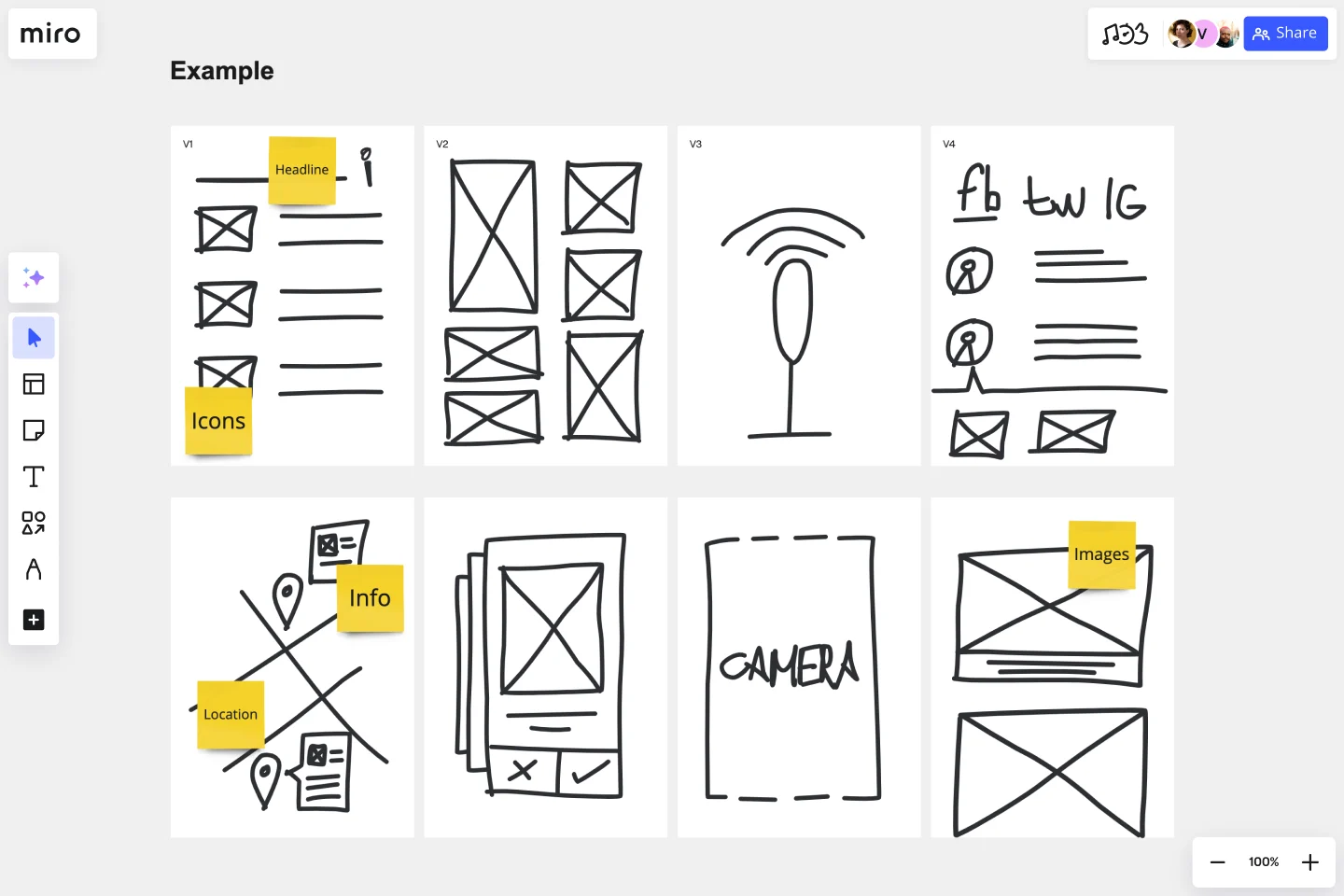Crazy Eights Template
Run wild with this Crazy Eights Method! Perfect for generating tons of ideas—fast! It is a design thinking method bringing unique perspectives in a visual idea to communicate your ideas.
About the Crazy Eights Template
What is Crazy Eights?
Crazy Eights is a quick and dirty sketch brainstorming exercise that challenges team members to sketch 8 ideas in 8 minutes. It keeps participants on their toes, forces quick thinking, and doesn’t allow time to weed out “bad ideas.” This is about quantity over quality and is a great way for your team to let loose and really push the boundaries of what’s possible.
When to use it
Crazy Eights is best used at the beginning stages of ideation. Keep the sessions small, just six to eight people. Whether you’re looking to redesign a website, the UX on a page, or even rebrand your company logo, it’s an effective way to kick-start the process.
How to use the Crazy Eights Template
Flexing your creative muscles has never been easier with Crazy Eights. Perfect for early stages of development, this ideation technique is a favorite for its fast-paced, time-boxed energy.
Step 1: Head to your Crazy Eights Template—since you’re working with distributed teams, we’ve generated a digital space with 8 clean boxes to make it simple.
Step 2: Use the Miro template. Using the 8 boxes in the Miro template, tell your team they have 8 minutes to sketch, draw, and ideate using the pen tool (or any other tool!) provided by Miro. This is not about perfection, but about output. Sketches can be as rough as you need!
Step 3: Make sure someone is keeping time. The timekeeper should update the team often so they can keep track and avoid wasting too much time on a single sketch.
Step 4: Repeat as many times as you want.
Step 5: Ask team members to present their top 3 ideas to the group. They should choose their 3 favorite ideas. Give them 6 more minutes to sketch out these ideas further. Then they can present them to the group.
Step 6: Vote! Using the voting tool provided by Miro, create a border around each board and dot vote.
What are the benefits of using the Crazy Eights for Brainstorming?
Crazy Eights is perfect for getting your own creative juices flowing during a brainstorm and drawing out ideas from colleagues. It’s short and fun—and most important, helps generate ideas. Not all of them will be great, but you can iterate, revise, and shape—as you and your teammates inspire each other.
When do I use the Crazy Eights for Ideation?
Crazy Eights is best used at the beginning stages of ideation. Keep the sessions small, just six to eight people. Whether you’re looking to redesign a website, the UX on a page, or even rebrand your company logo, it’s an effective way to kick-start the process.
Get started with this template right now.
Pass the Paper
Collaborative brainstorming is an excellent method to facilitate a group of individuals in generating a diverse range of innovative concepts related to a specific problem. By encouraging participants to build upon each other's ideas, the process allows for rapid evolution and unexpected transformations. This collaborative approach, known as Round Robin, emphasizes collective authorship, with each person contributing their unique perspective. The ultimate outcome is a collection of ideas that surpasses the imagination of any individual.
The Ultimate Storyboarding Template
Works best for:
Storyboard, Design, Planning
Elevate your storyboarding with The Ultimate Storyboarding Template. Designed for ultimate flexibility and detail, this template supports a wide range of projects, from films to product launches. It includes sections for scene breakdowns, character arcs, and visual elements, making it ideal for comprehensive storytelling. Use it to create detailed, engaging storyboards that communicate your vision clearly and effectively to your team and stakeholders.
Elevator Pitch Template
Elevator Pitch Boards are concise and effective tools to showcase your idea and generate interest from stakeholders. It's an opportunity to receive valuable feedback and ensure that your proposal aligns with your target audience's needs.
Flyer Maker Template
Works best for:
Design, Marketing
Whether it’s a client party or a nonprofit fundraiser, your event needs one key thing to be a smashing success: people to show up. That’s why promoting it is such an important part of the planning—and creating and sending a flyer is the first step. These single-page files will grab your guests’ attention and give them the key details, such as the time, date, and location (and if it’s a fundraiser, who/what the funds will benefit). This template will let you lay out text and customize a flyer design.
Empathy Mapping by ServiceNow
Works best for:
Research & Design, Market Research
The Empathy Mapping template helps teams capture detailed user insights. By understanding user perspectives, you can improve product features and customer satisfaction. This template is perfect for user research and product development.
Purple Sector Empathy Map
Works best for:
Market Research, Research & Design
Purple Sector Empathy Map is an innovative tool for exploring user experiences. By visualizing users' thoughts, feelings, and behaviors, you can create more engaging and user-friendly products. Ideal for teams focused on user experience.
